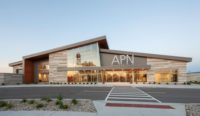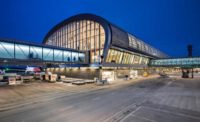Airport Terminal Recognized for Going Green

A nighttime shot of Long Beach Airport terminal. Image courtesy of HOK

Passengers can enjoy ample daylight at the newly modernized terminal. Image courtesy of HOK


The California Transportation Foundation awarded the City of Long Beach its 2013 Aviation Project of the Year award for Long Beach Airport’s new passenger concourse, designed by HOK. Every year the California Transportation Foundation recognizes outstanding transportation projects in the state. With a design that honors the airport’s heritage, the goals behind HOK’s design were to enhance the passenger experience and environmental performance while bringing back the excitement of flying.
Opening five months ahead of schedule, HOK’s Long Beach Airport Modernization project, which includes the new 45,000-square-foot, eleven-gate passenger concourse is the result of a long collaboration with Long Beach Airport. Since 2005, HOK worked with the airport to envision a comprehensive master plan for the airport’s existing facilities and future development. The award-winning new concourse emerged from an understanding of the airport’s need to be an up-to-date regional airport facility that can accommodate future growth and a community icon that embodies a special sense of place for the city.
The new terminal’s linear indoor-outdoor scheme was designed to complement the existing landmark terminal building. The original terminal, constructed in 1941 and registered as a Cultural Historical Landmark by the State of California, was designed by Long Beach architects W. Horace Austin and Kenneth Wing, Sr. The building is considered a masterpiece of early modern architecture.
The long, narrow bar scheme HOK developed was partly the result of working with environmental constraints that strictly limited square-footage. “These constraints led to unique solutions,” says Dave Holloway, HOK’s senior project manager on the project. By using a simple, efficient bar, the architects were able to symbolically engage the original landmark terminal by making it a focal point, drawing passengers along a new central axis and into a new outdoor “meeters-and-greeters” plaza.
Ernest Cirangle, design principal for HOK’s Los Angeles practice says, “We set out to do something that was in keeping with the local, indoor-outdoor experience and that celebrated the historical terminal without copying it or overpowering it. We felt our design had to be a little quiet, with no complicated ups and downs. It was important to keep it simple and easy to use.”
HOK maintained as much outdoor space as possible by maximizing opportunities for exterior circulation and keeping the original covered outdoor baggage claim areas. These elements all feed into a unifying central plaza that visually ties the landmark terminal to the new concourse with native gardens and rows of palm trees. Amenities to enhance the passenger experience, including iPad bar with free WiFi, were placed throughout.
“This concourse is about enjoyment and comfort,” says Cirangle. Concessions and services are mingled with waiting areas. In addition, to emphasize a sense of local identity, Long Beach Airport invited locally recognized restaurants and cafés to move in and energize HOK’s clean, do-more-with-less design, transforming the airport into a destination unto itself.
The linear design also lends itself to environmental efficiency by allowing for abundant daylighting. The lighting system is connected to photocells that automatically adjust artificial lighting levels in response to changes in daylight conditions. The building’s narrow profile, with everything on one level, also makes the terminal environmentally efficient. Moreover, the central native gardens, super-insulated walls, and energy-efficient low-E glass help to reduce heat gain and keep the terminal cool, reducing demand for HVAC.
As part of a comprehensive energy and resource strategy, the terminal, also employs low-flow fixtures, drip irrigation and uses its ample roof area for a photovoltaic array that will offset energy demands by 13 percent. The building’s environment and operations are also monitored by a building management system.
The new terminal is currently anticipated to receive a LEED Gold rating. As part of a growing trend, Long Beach Airport will then be among an elite group of airports nationwide to achieve LEED certification and the second to attain LEED Gold.
The terminal with its roof-mounted photovoltaic arrays, also garnered the airport the 2013 Energy and Leadership in Green Building award from the City of Long Beach.
Looking for a reprint of this article?
From high-res PDFs to custom plaques, order your copy today!







